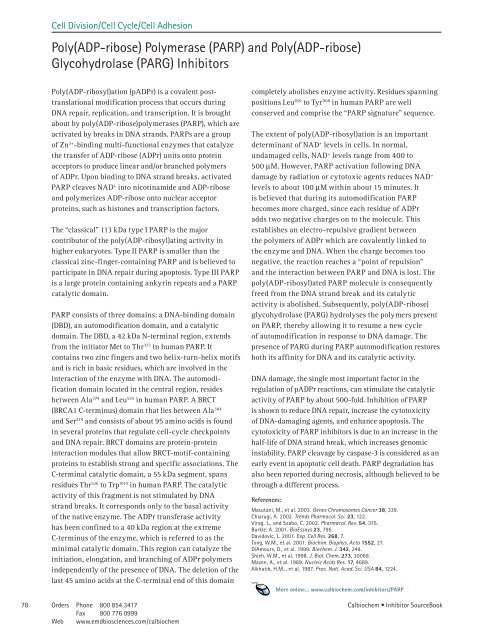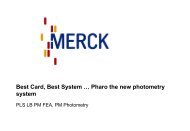Inhibitor SourceBook™ Second Edition
Inhibitor SourceBook™ Second Edition
Inhibitor SourceBook™ Second Edition
You also want an ePaper? Increase the reach of your titles
YUMPU automatically turns print PDFs into web optimized ePapers that Google loves.
Cell Division/Cell Cycle/Cell Adhesion<br />
Poly(ADP-ribose) Polymerase (PARP) and Poly(ADP-ribose)<br />
Glycohydrolase (PARG) <strong>Inhibitor</strong>s<br />
Poly(ADP-ribosyl)ation (pADPr) is a covalent posttranslational<br />
modification process that occurs during<br />
DNA repair, replication, and transcription. It is brought<br />
about by poly(ADP-ribose)polymerases (PARP), which are<br />
activated by breaks in DNA strands. PARPs are a group<br />
of Zn 2+ -binding multi-functional enzymes that catalyze<br />
the transfer of ADP-ribose (ADPr) units onto protein<br />
acceptors to produce linear and/or branched polymers<br />
of ADPr. Upon binding to DNA strand breaks, activated<br />
PARP cleaves NAD + into nicotinamide and ADP-ribose<br />
and polymerizes ADP-ribose onto nuclear acceptor<br />
proteins, such as histones and transcription factors.<br />
The “classical” 113 kDa type I PARP is the major<br />
contributor of the poly(ADP-ribosyl)ating activity in<br />
higher eukaryotes. Type II PARP is smaller than the<br />
classical zinc-finger-containing PARP and is believed to<br />
participate in DNA repair during apoptosis. Type III PARP<br />
is a large protein containing ankyrin repeats and a PARP<br />
catalytic domain.<br />
PARP consists of three domains: a DNA-binding domain<br />
(DBD), an automodification domain, and a catalytic<br />
domain. The DBD, a 42 kDa N-terminal region, extends<br />
from the initiator Met to Thr 373 in human PARP. It<br />
contains two zinc fingers and two helix-turn-helix motifs<br />
and is rich in basic residues, which are involved in the<br />
interaction of the enzyme with DNA. The automodi-<br />
fication domain located in the central region, resides<br />
between Ala 374 and Leu 525 in human PARP. A BRCT<br />
(BRCA1 C-terminus) domain that lies between Ala 384<br />
and Ser 479 and consists of about 95 amino acids is found<br />
in several proteins that regulate cell-cycle checkpoints<br />
and DNA repair. BRCT domains are protein-protein<br />
interaction modules that allow BRCT-motif-containing<br />
proteins to establish strong and specific associations. The<br />
C-terminal catalytic domain, a 55 kDa segment, spans<br />
residues Thr 526 to Trp 1014 in human PARP. The catalytic<br />
activity of this fragment is not stimulated by DNA<br />
strand breaks. It corresponds only to the basal activity<br />
of the native enzyme. The ADPr transferase activity<br />
has been confined to a 40 kDa region at the extreme<br />
C-terminus of the enzyme, which is referred to as the<br />
minimal catalytic domain. This region can catalyze the<br />
initiation, elongation, and branching of ADPr polymers<br />
independently of the presence of DNA. The deletion of the<br />
last 45 amino acids at the C-terminal end of this domain<br />
completely abolishes enzyme activity. Residues spanning<br />
positions Leu 859 to Tyr 908 in human PARP are well<br />
conserved and comprise the “PARP signature” sequence.<br />
The extent of poly(ADP-ribosyl)ation is an important<br />
determinant of NAD + levels in cells. In normal,<br />
undamaged cells, NAD + levels range from 400 to<br />
500 mM. However, PARP activation following DNA<br />
damage by radiation or cytotoxic agents reduces NAD +<br />
levels to about 100 mM within about 15 minutes. It<br />
is believed that during its automodification PARP<br />
becomes more charged, since each residue of ADPr<br />
adds two negative charges on to the molecule. This<br />
establishes an electro-repulsive gradient between<br />
the polymers of ADPr which are covalently linked to<br />
the enzyme and DNA. When the charge becomes too<br />
negative, the reaction reaches a “point of repulsion”<br />
and the interaction between PARP and DNA is lost. The<br />
poly(ADP-ribosyl)ated PARP molecule is consequently<br />
freed from the DNA strand break and its catalytic<br />
activity is abolished. Subsequently, poly(ADP-ribose)<br />
glycohydrolase (PARG) hydrolyses the polymers present<br />
on PARP, thereby allowing it to resume a new cycle<br />
of automodification in response to DNA damage. The<br />
presence of PARG during PARP automodification restores<br />
both its affinity for DNA and its catalytic activity.<br />
DNA damage, the single most important factor in the<br />
regulation of pADPr reactions, can stimulate the catalytic<br />
activity of PARP by about 500-fold. Inhibition of PARP<br />
is shown to reduce DNA repair, increase the cytotoxicity<br />
of DNA-damaging agents, and enhance apoptosis. The<br />
cytotoxicity of PARP inhibitors is due to an increase in the<br />
half-life of DNA strand break, which increases genomic<br />
instability. PARP cleavage by caspase-3 is considered as an<br />
early event in apoptotic cell death. PARP degradation has<br />
also been reported during necrosis, although believed to be<br />
through a different process.<br />
References:<br />
Masutani, M., et al. 2003. Genes Chromosomes Cancer 38, 339.<br />
Chiarugi, A. 2002. Trends Pharmacol. Sci. 23, 22.<br />
Virag. L., and Szabo, C. 2002. Pharmacol. Rev. 54, 375.<br />
Burkle, A. 200 . BioEssays 23, 795.<br />
Davidovic, L. 200 . Exp. Cell Res. 268, 7.<br />
Tong, W.M., et al. 200 . Biochim. Biophys. Acta 1552, 27.<br />
DíAmours, D., et al. 999. Biochem. J. 342, 249.<br />
Shieh, W.M., et al. 998. J. Biol. Chem. 273, 30069.<br />
Mazen, A., et al. 989. Nucleic Acids Res. 17, 4689.<br />
Alkhatib, H.M.., et al. 987. Proc. Natl. Acad. Sci. USA 84, 224.<br />
More online... www.calbiochem.com/inhibitors/PARP<br />
78 Orders Phone 800 854 34 7<br />
Calbiochem • <strong>Inhibitor</strong> SourceBook<br />
Fax 800 776 0999<br />
Web www.emdbiosciences.com/calbiochem



